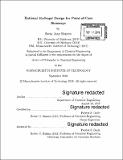| dc.contributor.advisor | Patrick S. Doyle. | en_US |
| dc.contributor.author | Shapiro, Sarah Jane,1991- | en_US |
| dc.contributor.other | Massachusetts Institute of Technology. Department of Chemical Engineering. | en_US |
| dc.date.accessioned | 2020-09-25T20:03:59Z | |
| dc.date.available | 2020-09-25T20:03:59Z | |
| dc.date.copyright | 2019 | en_US |
| dc.date.issued | 2019 | en_US |
| dc.identifier.uri | https://hdl.handle.net/1721.1/127714 | |
| dc.description | Thesis: Ph. D., Massachusetts Institute of Technology, Department of Chemical Engineering, May, 2019 | en_US |
| dc.description | Cataloged from the official PDF of thesis. | en_US |
| dc.description | Includes bibliographical references (pages 125-146). | en_US |
| dc.description.abstract | As the global disease burden shifts increasingly towards chronic diseases, there is a need for improved diagnosis and monitoring so that patients can get the care they need. This is particularly evident in the developing world, where many people live far from diagnostic laboratories. Point-of-care diagnostics are tests that can be run in doctor's offices, clinics, and in patient homes. These tests must be rapid, so that they can be run quickly while the patient waits for results. Established point-of-care technologies are largely centered on lateral flow assays. Hydrogel microparticles have been used extensively for bioassays due to their nonfouling nature and ability to be functionalized with different types of biomolecules. Here, we use polyethylene glycol hydrogel particles to develop point-of-care bioassays. We focus on two different biomarkers: proteins and microRNA. | en_US |
| dc.description.abstract | Proteins are well established clinical biomarkers that are regularly tested to diagnose a number of different diseases. miRNA are emerging biomarkers that were discovered within the past thirty years and have dysregulation patterns that are implicated in a wide variety of diseases. The aim of this thesis is to enable hydrogel-based point-of-care detection of miRNA and proteins by developing and applying theory to aid in rational design of the bioassay. First, we establish a theoretical framework to investigate the key factors that influence bioassay signal for hydrogel-based rapid bioassays. By developing scaling arguments for the flux of target into the hydrogel, we find that the key factors that influence bioassay signal are the reaction rate constant, the diffusion coefficient of the target in the gel, the probe concentration, the target concentration, the assay time, and the shape of the hydrogel. | en_US |
| dc.description.abstract | By changing the hydrogel particle shape, we are able to decrease the limit of detection of a protein assay by a factor of six. We then apply the theory we developed for hydrogel signal to an assay for microRNA. Using the theory, we are able to design the hydrogels to enable muultiplexed detection of miRNA directly from serum in a 40-minute assay, with a clinically-relevant limit of detection. This assay only requires minimal preprocessing of the serum, making it useful for point-of-care applications. Leveraging our theoretical knowledge, we also develop a new assay format by incorporating hydrogels into fibrous substrates such as nitrocellulose, glass fiber membranes, and silk fabric and demonstrating their utility for bioassays. We demonstrate that these constructs can be used for detection of both miRNA and proteins. | en_US |
| dc.description.abstract | This work combines the fields of flexible fibrous materials and lithographic patterning to directly pattern hydrogels of varying shape and function within fibrous substrates. The work presented in this thesis demonstrates the utility of hydrogels for point-of-care applications. We believe that this work can be leveraged in the future to develop tests for additional biomarkers and can be combined with advances in fluorescence imaging and portable heating to create point-of-care devices that can quickly and reliably quantify proteins and miRNA from complex samples, in order to enable earlier diagnosis of disease. | en_US |
| dc.description.statementofresponsibility | by Sarah Jane Shapiro. | en_US |
| dc.format.extent | 146 pages | en_US |
| dc.language.iso | eng | en_US |
| dc.publisher | Massachusetts Institute of Technology | en_US |
| dc.rights | MIT theses may be protected by copyright. Please reuse MIT thesis content according to the MIT Libraries Permissions Policy, which is available through the URL provided. | en_US |
| dc.rights.uri | http://dspace.mit.edu/handle/1721.1/7582 | en_US |
| dc.subject | Chemical Engineering. | en_US |
| dc.title | Rational hydrogel design for point-of-care bioassays | en_US |
| dc.type | Thesis | en_US |
| dc.description.degree | Ph. D. | en_US |
| dc.contributor.department | Massachusetts Institute of Technology. Department of Chemical Engineering | en_US |
| dc.identifier.oclc | 1196087455 | en_US |
| dc.description.collection | Ph.D. Massachusetts Institute of Technology, Department of Chemical Engineering | en_US |
| dspace.imported | 2020-09-25T20:03:58Z | en_US |
| mit.thesis.degree | Doctoral | en_US |
| mit.thesis.department | ChemEng | en_US |
